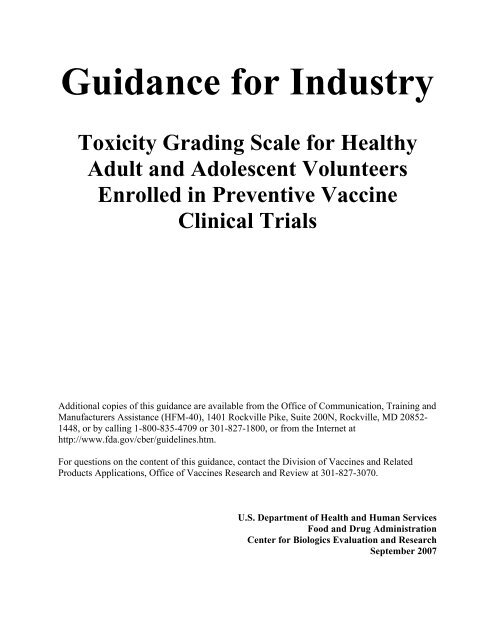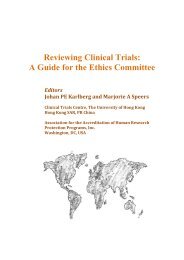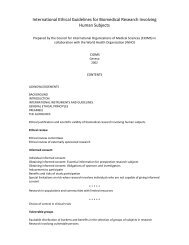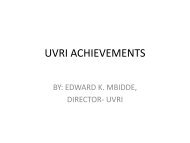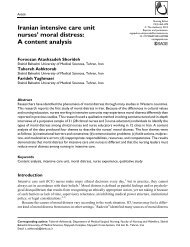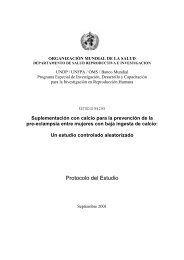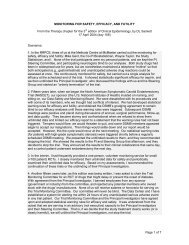Toxicity Grading Scale for Healthy Adult and Adolescent Volunteers ...
Toxicity Grading Scale for Healthy Adult and Adolescent Volunteers ...
Toxicity Grading Scale for Healthy Adult and Adolescent Volunteers ...
Create successful ePaper yourself
Turn your PDF publications into a flip-book with our unique Google optimized e-Paper software.
Guidance <strong>for</strong> Industry<br />
<strong>Toxicity</strong> <strong>Grading</strong> <strong>Scale</strong> <strong>for</strong> <strong>Healthy</strong><br />
<strong>Adult</strong> <strong>and</strong> <strong>Adolescent</strong> <strong>Volunteers</strong><br />
Enrolled in Preventive Vaccine<br />
Clinical Trials<br />
Additional copies of this guidance are available from the Office of Communication, Training <strong>and</strong><br />
Manufacturers Assistance (HFM-40), 1401 Rockville Pike, Suite 200N, Rockville, MD 20852-<br />
1448, or by calling 1-800-835-4709 or 301-827-1800, or from the Internet at<br />
http://www.fda.gov/cber/guidelines.htm.<br />
For questions on the content of this guidance, contact the Division of Vaccines <strong>and</strong> Related<br />
Products Applications, Office of Vaccines Research <strong>and</strong> Review at 301-827-3070.<br />
U.S. Department of Health <strong>and</strong> Human Services<br />
Food <strong>and</strong> Drug Administration<br />
Center <strong>for</strong> Biologics Evaluation <strong>and</strong> Research<br />
September 2007
Contains Nonbinding Recommendations<br />
Table of Contents<br />
I. INTRODUCTION............................................................................................................. 1<br />
II. BACKGROUND ............................................................................................................... 2<br />
III. TOXICITY GRADING SCALE TABLES..................................................................... 2<br />
A. Tables <strong>for</strong> Clinical Abnormalities ....................................................................... 3<br />
B. Tables <strong>for</strong> Laboratory Abnormalities................................................................. 6<br />
IV. REFERENCES.................................................................................................................. 8<br />
i
Contains Nonbinding Recommendations<br />
Guidance <strong>for</strong> Industry<br />
<strong>Toxicity</strong> <strong>Grading</strong> <strong>Scale</strong> <strong>for</strong> <strong>Healthy</strong> <strong>Adult</strong> <strong>and</strong> <strong>Adolescent</strong><br />
<strong>Volunteers</strong> Enrolled in Preventive Vaccine Clinical Trials<br />
This guidance represents the Food <strong>and</strong> Drug Administration’s (FDA’s) current thinking on this<br />
topic. It does not create or confer any rights <strong>for</strong> or on any person <strong>and</strong> does not operate to bind<br />
FDA or the public. You can use an alternative approach if the approach satisfies the<br />
requirements of the applicable statutes <strong>and</strong> regulations. If you want to discuss an alternative<br />
approach, contact the appropriate FDA staff. If you cannot identify the appropriate FDA staff,<br />
call the appropriate number listed on the title page of this guidance.<br />
I. INTRODUCTION<br />
Preventive vaccines are usually developed to prevent disease in a healthy population. The Office<br />
of Vaccines Research <strong>and</strong> Review, Center <strong>for</strong> Biologics Evaluation <strong>and</strong> Research, regulates<br />
preventive vaccines under authority of section 351 of the Public Health Service Act (42 U.S.C.<br />
262), as well as specific sections of the Federal Food, Drug, <strong>and</strong> Cosmetic Act, <strong>and</strong> reviews<br />
investigational new drug applications (INDs) <strong>and</strong> biologics license applications (BLAs). (See,<br />
<strong>for</strong> example, Title 21 Code of Federal Regulations (CFR) Parts 312, 600, <strong>and</strong> 601). Most of the<br />
clinical trials of preventive vaccines conducted to support INDs <strong>and</strong> BLAs enroll healthy<br />
volunteers in all phases of vaccine testing. The enrollment of healthy volunteers warrants a very<br />
low tolerance <strong>for</strong> risk in those clinical trials.<br />
This guidance provides you, sponsors, monitors, <strong>and</strong> investigators of vaccine trials, with<br />
recommendations on assessing the severity of clinical <strong>and</strong> laboratory abnormalities in healthy<br />
adult <strong>and</strong> adolescent volunteers enrolled in clinical trials. The grading system described in the<br />
table can also be useful in defining a particular study’s stopping rules (e.g., a certain number of<br />
adverse events, as defined in the table, may call <strong>for</strong> stopping the study). Less extreme<br />
observations (e.g., mild) may not require discontinuing the study vaccine but can still contribute<br />
to evaluating safety by identifying parameters to focus upon in subsequent product development.<br />
Uni<strong>for</strong>m criteria <strong>for</strong> categorizing toxicities in healthy volunteers can improve comparisons of<br />
safety data among groups within the same study <strong>and</strong> also between different studies. We, FDA,<br />
recommend using toxicity grading scale tables, provided below, as a guideline <strong>for</strong> selecting the<br />
assessment criteria to be used in a clinical trial of a preventive vaccine. We recommend<br />
incorporation of such appropriate, uni<strong>for</strong>m, criteria into the investigational plan, case report<br />
<strong>for</strong>ms, <strong>and</strong> study reports <strong>and</strong> correspondence with FDA, sponsors, monitors, investigators, <strong>and</strong><br />
IRBs.<br />
This guidance finalizes the draft guidance of the same title dated April 2005 (70 FR 22664, May<br />
2, 2005).<br />
1
Contains Nonbinding Recommendations<br />
FDA’s guidance documents, including this guidance, do not establish legally en<strong>for</strong>ceable<br />
responsibilities. Instead, guidances describe FDA’s current thinking on a topic <strong>and</strong> should be<br />
viewed only as recommendations, unless specific regulatory or statutory requirements are cited.<br />
The use of the word should in FDA’s guidances means that something is suggested or<br />
recommended, but not required.<br />
II.<br />
BACKGROUND<br />
St<strong>and</strong>ardized toxicity assessment scales have been widely used to evaluate products treating<br />
specific diseases. For example, the National Cancer Institute’s Common <strong>Toxicity</strong> Criteria <strong>Scale</strong><br />
<strong>and</strong> the Division of AIDS’ <strong>Toxicity</strong> <strong>Grading</strong> <strong>Scale</strong> st<strong>and</strong>ardize the evaluation of adverse events<br />
among patients with cancer <strong>and</strong> HIV/AIDS, respectively (Refs. 1, 2). The defined toxicity<br />
parameters in those scales are designed <strong>for</strong> patients who may already experience mild, moderate,<br />
or severe adverse clinical or laboratory events due to the disease process, <strong>and</strong> may not be<br />
appropriate <strong>for</strong> healthy volunteers.<br />
In the development of the toxicity grading scales <strong>for</strong> healthy volunteers, we chose parameter<br />
limit values based on published in<strong>for</strong>mation, when such values were available (Refs. 1-6). For<br />
example, the Brighton Collaboration has developed case definitions <strong>and</strong> guidelines to evaluate<br />
some adverse events associated with administering vaccines (Ref. 3). In some cases, parameter<br />
limit values were based on clinical experience <strong>and</strong> experience reviewing vaccine clinical trials<br />
that enroll normal healthy subjects.<br />
<strong>Toxicity</strong> grading scales <strong>for</strong> laboratory abnormalities should consider the local laboratory<br />
reference values when the parameter limit values are defined. The characterization of laboratory<br />
parameters among some populations of healthy adults <strong>and</strong> adolescents may require the exercise<br />
of clinical judgment, <strong>for</strong> example, consideration of the potential <strong>for</strong> ethnic differences in white<br />
blood cell (WBC) counts or gender differences in creatine phosphokinase (CPK) values.<br />
III.<br />
TOXICITY GRADING SCALE TABLES<br />
Adverse events in a clinical trial of an investigational vaccine must be recorded <strong>and</strong> monitored<br />
<strong>and</strong>, when appropriate, reported to FDA <strong>and</strong> others involved in an investigation (sponsors, IRBs,<br />
<strong>and</strong> investigators). (See, <strong>for</strong> example, 21 CFR 312.32, 312.33, 312.50, 312.55, 312.56, 312.60,<br />
312.62, 312.64, 312.66). Although the use of a toxicity grading scale <strong>for</strong> adverse events would<br />
not replace these regulatory requirements, using a scale to categorize adverse events observed<br />
during a clinical trial may assist you in monitoring safety <strong>and</strong> making required reports.<br />
Nonetheless, we believe that categorization or grading of data as outlined in this document is<br />
supplementary to <strong>and</strong> should not replace full <strong>and</strong> complete data analysis.<br />
These guidelines <strong>for</strong> toxicity grading scales are primarily intended <strong>for</strong> healthy adult <strong>and</strong><br />
adolescent volunteers. The parameters in the tables below are not necessarily applicable to every<br />
clinical trial of healthy volunteers. The parameters monitored should be appropriate <strong>for</strong> the<br />
specific study vaccine. For some preventive vaccines under development, it may be appropriate<br />
2
Contains Nonbinding Recommendations<br />
to include additional parameters to be monitored during a clinical trial or to alter the choice of<br />
values in the toxicity table. For example, additional parameters might be added based on one or<br />
more of the following: safety signals observed in pre-clinical toxicology studies, the biological<br />
plausibility of the occurrence of certain adverse events, or previous experience with a similar<br />
licensed product.<br />
As discussed above, the tables do not represent a recommendation to monitor all the listed<br />
parameters in all clinical trials of healthy volunteers, nor do the tables represent all possible<br />
parameters to be monitored. In addition, these tables do not represent study inclusion or<br />
exclusion criteria. We recommend that the parameters monitored be appropriate <strong>for</strong> the study<br />
vaccine administered to healthy volunteers participating in the clinical trial.<br />
A. Tables <strong>for</strong> Clinical Abnormalities<br />
Local Reaction to<br />
Injectable Product<br />
Pain<br />
Mild (Grade 1) Moderate(Grade 2) Severe (Grade 3) Potentially Life<br />
Threatening<br />
(Grade 4)<br />
Does not interfere<br />
with activity<br />
Repeated use of nonnarcotic<br />
pain reliever<br />
> 24 hours or<br />
interferes with<br />
activity<br />
Any use of<br />
narcotic pain<br />
reliever or<br />
prevents daily<br />
activity<br />
Emergency room<br />
(ER) visit or<br />
hospitalization<br />
Tenderness<br />
Mild discom<strong>for</strong>t to<br />
touch<br />
Discom<strong>for</strong>t with<br />
movement<br />
Significant<br />
discom<strong>for</strong>t at rest<br />
Erythema/Redness * 2.5 – 5 cm 5.1 – 10 cm > 10 cm Necrosis or<br />
exfoliative<br />
dermatitis<br />
Induration/Swelling **<br />
2.5 – 5 cm <strong>and</strong><br />
does not interfere<br />
with activity<br />
5.1 – 10 cm or<br />
interferes with<br />
activity<br />
> 10 cm or<br />
prevents daily<br />
activity<br />
ER visit or<br />
hospitalization<br />
Necrosis<br />
* In addition to grading the measured local reaction at the greatest single diameter, the measurement should be<br />
recorded as a continuous variable.<br />
** Induration/Swelling should be evaluated <strong>and</strong> graded using the functional scale as well as the actual measurement.<br />
3
Contains Nonbinding Recommendations<br />
Vital Signs * Mild (Grade 1) Moderate(Grade 2) Severe (Grade 3) Potentially Life<br />
Threatening<br />
(Grade 4)<br />
Fever (°C) **<br />
38.0 – 38.4 38.5 – 38.9<br />
39.0 – 40 > 40<br />
(°F) **<br />
Tachycardia - beats per<br />
minute<br />
Bradycardia - beats per<br />
minute***<br />
Hypertension (systolic) -<br />
mm Hg<br />
Hypertension (diastolic) -<br />
mm Hg<br />
Hypotension (systolic) –<br />
mm Hg<br />
100.4 – 101.1 101.2 – 102.0 102.1 – 104 > 104<br />
101 – 115 116 – 130 > 130 ER visit or<br />
hospitalization <strong>for</strong><br />
arrhythmia<br />
50 – 54 45 – 49 < 45 ER visit or<br />
hospitalization <strong>for</strong><br />
arrhythmia<br />
141 – 150 151 – 155 > 155 ER visit or<br />
hospitalization <strong>for</strong><br />
malignant<br />
hypertension<br />
91 – 95 96 – 100 > 100 ER visit or<br />
hospitalization <strong>for</strong><br />
malignant<br />
hypertension<br />
85 – 89 80 – 84 < 80 ER visit or<br />
hospitalization <strong>for</strong><br />
hypotensive shock<br />
Respiratory Rate – breaths 17 – 20 21 – 25 > 25 Intubation<br />
per minute<br />
* Subject should be at rest <strong>for</strong> all vital sign measurements.<br />
** Oral temperature; no recent hot or cold beverages or smoking.<br />
*** When resting heart rate is between 60 – 100 beats per minute. Use clinical judgement when characterizing<br />
bradycardia among some healthy subject populations, <strong>for</strong> example, conditioned athletes.<br />
Systemic (General) Mild (Grade 1) Moderate(Grade 2) Severe (Grade 3) Potentially Life<br />
Threatening<br />
(Grade 4)<br />
Nausea/vomiting<br />
Diarrhea<br />
Headache<br />
Fatigue<br />
Myalgia<br />
No interference<br />
with activity or 1 – 2<br />
episodes/24 hours<br />
2 – 3 loose stools or<br />
< 400 gms/24 hours<br />
No interference with<br />
activity<br />
No interference with<br />
activity<br />
No interference with<br />
activity<br />
Some interference<br />
with activity or > 2<br />
episodes/24 hours<br />
4 – 5 stools or<br />
400 – 800 gms/24<br />
hours<br />
Repeated use of nonnarcotic<br />
pain<br />
reliever > 24 hours or<br />
some interference<br />
with activity<br />
Some interference<br />
with activity<br />
Some interference<br />
with activity<br />
Prevents daily<br />
activity, requires<br />
outpatient IV<br />
hydration<br />
6 or more watery<br />
stools or<br />
> 800gms/24 hours<br />
or requires<br />
outpatient IV<br />
hydration<br />
Significant; any<br />
use of narcotic<br />
pain reliever or<br />
prevents daily<br />
activity<br />
Significant;<br />
prevents daily<br />
activity<br />
Significant;<br />
prevents daily<br />
activity<br />
ER visit or<br />
hospitalization <strong>for</strong><br />
hypotensive shock<br />
ER visit or<br />
hospitalization<br />
ER visit or<br />
hospitalization<br />
ER visit or<br />
hospitalization<br />
ER visit or<br />
hospitalization<br />
4
Contains Nonbinding Recommendations<br />
Systemic Illnes Mild (Grade 1) (Moderate(Grade 2) Severe (Grade 3) Potentially Life<br />
Threatening<br />
(Grade 4)<br />
Illness or clinical adverse<br />
event (as defined<br />
according to applicable<br />
regulations)<br />
No interference with<br />
activity<br />
Some interference<br />
with activity not<br />
requiring medical<br />
intervention<br />
Prevents daily<br />
activity <strong>and</strong><br />
requires medical<br />
intervention<br />
ER visit or<br />
hospitalization<br />
5
Contains Nonbinding Recommendations<br />
B. Tables <strong>for</strong> Laboratory Abnormalities<br />
The laboratory values provided in the tables below serve as guidelines <strong>and</strong> are dependent<br />
upon institutional normal parameters. Institutional normal reference ranges should be<br />
provided to demonstrate that they are appropriate.<br />
Serum * Mild (Grade 1) Moderate<br />
(Grade 2)<br />
Severe<br />
(Grade 3)<br />
Sodium – Hyponatremia mEq/L 132 – 134 130 – 131 125 – 129 < 125<br />
Sodium – Hypernatremia mEq/L 144 – 145 146 – 147 148 – 150 > 150<br />
Potassium – Hyperkalemia mEq/L 5.1 – 5.2 5.3 – 5.4 5.5 – 5.6 > 5.6<br />
Potassium – Hypokalemia mEq/L 3.5 – 3.6 3.3 – 3.4 3.1 – 3.2 < 3.1<br />
Glucose – Hypoglycemia mg/dL 65 – 69 55 – 64 45 – 54 < 45<br />
Glucose – Hyperglycemia<br />
Fasting – mg/dL<br />
R<strong>and</strong>om – mg/dL<br />
100 – 110<br />
110 – 125<br />
111 – 125<br />
126 – 200<br />
>125<br />
>200<br />
Potentially Life<br />
Threatening<br />
(Grade 4)**<br />
Insulin<br />
requirements or<br />
hyperosmolar<br />
coma<br />
Blood Urea Nitrogen<br />
BUN mg/dL<br />
23 – 26 27 – 31 > 31 Requires<br />
dialysis<br />
Creatinine – mg/dL 1.5 – 1.7 1.8 – 2.0 2.1 – 2.5 > 2.5 or requires<br />
dialysis<br />
Calcium – hypocalcemia mg/dL 8.0 – 8.4 7.5 – 7.9 7.0 – 7.4 < 7.0<br />
Calcium – hypercalcemia mg/dL 10.5 – 11.0 11.1 – 11.5 11.6 – 12.0 > 12.0<br />
Magnesium – hypomagnesemia mg/dL 1.3 – 1.5 1.1 – 1.2 0.9 – 1.0 < 0.9<br />
Phosphorous – hypophosphatemia 2.3 – 2.5 2.0 – 2.2 1.6 – 1.9 < 1.6<br />
mg/dL<br />
CPK – mg/dL<br />
1.25 – 1.5 x 1.6 – 3.0 x ULN 3.1 –10 x ULN > 10 x ULN<br />
ULN***<br />
Albumin – Hypoalbuminemia g/dL 2.8 – 3.1 2.5 – 2.7 < 2.5 --<br />
Total Protein – Hypoproteinemia g/dL 5.5 – 6.0 5.0 – 5.4 < 5.0 --<br />
Alkaline phosphate –<br />
1.1 – 2.0 x ULN 2.1 – 3.0 x ULN 3.1 – 10 x ULN > 10 x ULN<br />
increase by factor<br />
Liver Function Tests –ALT, AST 1.1 – 2.5 x ULN 2.6 – 5.0 x ULN 5.1 – 10 x ULN > 10 x ULN<br />
increase by factor<br />
Bilirubin – when accompanied<br />
by any increase in Liver Function Test<br />
increase by factor<br />
1.1 – 1.25 x ULN 1.26 – 1.5 x ULN 1.51 – 1.75 x ULN > 1.75 x ULN<br />
Bilirubin – when Liver Function Test 1.1 – 1.5 x ULN 1.6 – 2.0 x ULN 2.0 – 3.0 x ULN > 3.0 x ULN<br />
is normal; increase by factor<br />
Cholesterol 201 – 210 211 – 225 > 226 ---<br />
Pancreatic enzymes – amylase, lipase 1.1 – 1.5 x ULN 1.6 – 2.0 x ULN 2.1 – 5.0 x ULN > 5.0 x ULN<br />
* The laboratory values provided in the tables serve as guidelines <strong>and</strong> are dependent upon institutional normal<br />
parameters. Institutional normal reference ranges should be provided to demonstrate that they are appropriate.<br />
** The clinical signs or symptoms associated with laboratory abnormalities might result in characterization of the<br />
laboratory abnormalities as Potentially Life Threatening (Grade 4). For example. a low sodium value that falls<br />
within a grade 3 parameter (125-129 mE/L) should be recorded as a grade 4 hyponatremia event if the subject had a<br />
new seizure associated with the low sodium value.<br />
***ULN” is the upper limit of the normal range.<br />
6
Contains Nonbinding Recommendations<br />
Hematology * Mild (Grade 1) Moderate<br />
(Grade 2)<br />
Severe (Grade 3)<br />
Potentially Life<br />
Threatening<br />
(Grade 4)<br />
Hemoglobin (Female) - gm/dL 11.0 – 12.0 9.5 – 10.9 8.0 – 9.4 < 8.0<br />
Hemoglobin (Female)<br />
Any decrease – 1.5 1.6 – 2.0 2.1 – 5.0 > 5.0<br />
change from baseline value - gm/dL<br />
Hemoglobin (Male) - gm/dL 12.5 – 13.5 10.5 – 12.4 8.5 – 10.4 < 8.5<br />
Hemoglobin (Male)<br />
Any decrease – 1.5 1.6 – 2.0 2.1 – 5.0 > 5.0<br />
change from baseline value – gm/dL<br />
WBC Increase - cell/mm 3 10,800 – 15,000 15,001 – 20,000 20,001 – 25, 000 > 25,000<br />
WBC Decrease - cell/mm 3 2,500 – 3,500 1,500 – 2,499 1,000 – 1,499 < 1,000<br />
Lymphocytes Decrease - cell/mm 3 750 – 1,000 500 – 749 250 – 499 < 250<br />
Neutrophils Decrease - cell/mm 3 1,500 – 2,000 1,000 – 1,499 500 – 999 < 500<br />
Eosinophils - cell/mm 3 650 – 1500 1501 - 5000 > 5000 Hypereosinophilic<br />
Platelets Decreased - cell/mm 3 125,000 – 140,000 100,000 – 124,000 25,000 – 99,000 < 25,000<br />
PT – increase by factor<br />
1.0 – 1.10 x 1.11 – 1.20 x ULN 1.21 – 1.25 x ULN > 1.25 ULN<br />
(prothrombin time)<br />
ULN**<br />
PTT – increase by factor<br />
1.0 – 1.2 x ULN 1.21 – 1.4 x ULN 1.41 – 1.5 x ULN > 1.5 x ULN<br />
(partial thromboplastin time)<br />
Fibrinogen increase - mg/dL 400 – 500 501 – 600 > 600 --<br />
Fibrinogen decrease - mg/dL 150 – 200 125 – 149 100 – 124 < 100 or associated<br />
with gross bleeding<br />
or disseminated<br />
intravascular<br />
coagulation (DIC)<br />
* The laboratory values provided in the tables serve as guidelines <strong>and</strong> are dependent upon institutional normal<br />
parameters. Institutional normal reference ranges should be provided to demonstrate that they are appropriate.<br />
** “ULN” is the upper limit of the normal range.<br />
Urine * Mild (Grade 1) Moderate<br />
(Grade 2)<br />
Severe (Grade 3)<br />
Potentially Life<br />
Threatening<br />
(Grade 4)<br />
Protein Trace 1+ 2+ Hospitalization or<br />
dialysis<br />
Glucose Trace 1+ 2+ Hospitalization <strong>for</strong><br />
hyperglycemia<br />
Blood (microscopic) –<br />
red blood cells per<br />
high power field (rbc/hpf)<br />
1 - 10 11 – 50 > 50 <strong>and</strong>/or gross<br />
blood<br />
* The laboratory values provided in the tables serve as guidelines <strong>and</strong> are dependent upon institutional normal<br />
parameters. Institutional normal reference ranges should be provided to demonstrate that they are appropriate.<br />
Hospitalization or<br />
packed red blood<br />
cells (PRBC)<br />
transfusion<br />
7
Contains Nonbinding Recommendations<br />
IV.<br />
REFERENCES<br />
1. National Cancer Institute Common <strong>Toxicity</strong> Criteria, April 30, 1999.<br />
(http://ctep.cancer.gov/reporting/CTC-3.html)<br />
2. Division of AIDS Table <strong>for</strong> <strong>Grading</strong> Severity of <strong>Adult</strong> Adverse Experiences; August 1992.<br />
(http://rcc.tech-res-intl.com/tox_tables.htm)<br />
3. The Brighton Collaboration. Finalized Case Definitions <strong>and</strong> Guidelines.<br />
(http://brightoncollaboration.org/internet/en/index/definition___guidelines.html)<br />
4. HIV Vaccine Trials Network Table <strong>for</strong> <strong>Grading</strong> Severity of Adverse Experiences; September<br />
18, 2002. (http://rcc.tech-res-intl.com/tox_tables.htm)<br />
5. Division of AIDS Table <strong>for</strong> <strong>Grading</strong> the Severity of <strong>Adult</strong> <strong>and</strong> Pediatric Adverse Events,<br />
December 2004.<br />
(http://www3.niaid.nih.gov/research/resources/DAIDSClinRsrch/PDF/Safety/DAIDSAEGra<br />
dingTable.pdf)<br />
6. Kratz A, Ferraro M, Sluss PM, Lew<strong>and</strong>rowski KB. Laboratory Reference Values. New<br />
Engl<strong>and</strong> Journal of Medicine. 2004;351:1548-1563.<br />
8


